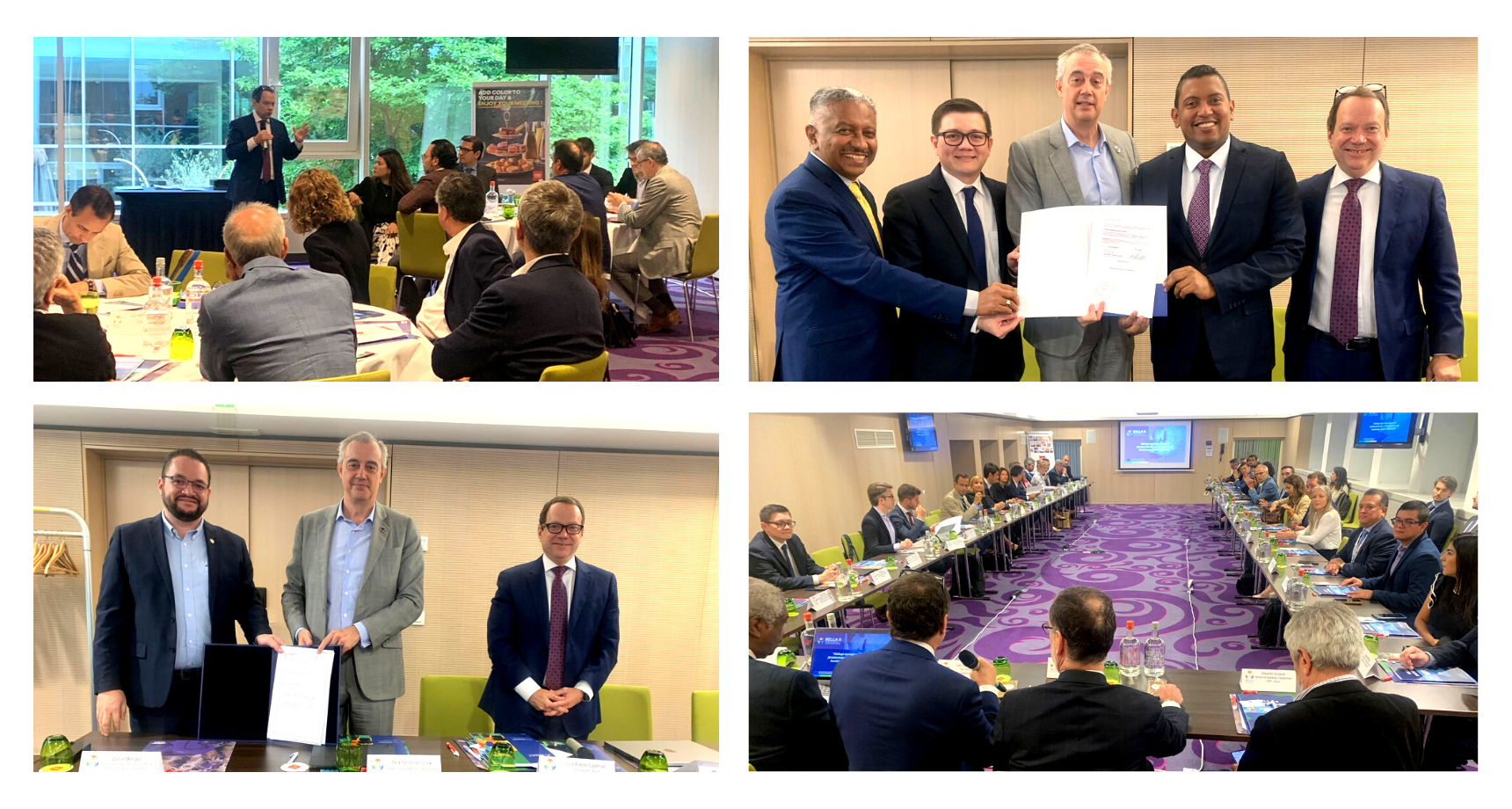Several actors and stakeholders from the digital ecosystem of Latin America and the Caribbean (LAC) and Europe participated in the first BELLA II Open Strategic Dialogue, which took place on 18 July in Brussels, Belgium, in the framework of the III EU-CELAC Summit of Heads of State.
The dialogue was the starting point of a process of discussion and generation of proposals, led by RedCLARA during the first year of implementation of the project, and was attended by some 60 representatives of multilateral investment banks, the national research and education networks (NRENs), telecommunications providers, the governments of Peru, Guatemala, Panama, and El Salvador, the Directorate General for International Partnerships (DG INTPA) and the Directorate General for Networks, Content and Communications Technology of the European Commission (DG CNET).
“It is very relevant to kick off the BELLA II strategic dialogues in the framework of the EU-CELAC Summit, as a symbol of what both regions can do together, if we choose to create value, through collaboration,” said Luis Eliécer Cadenas, Executive director of RedCLARA.
Cadenas thanked the European Commission for its historical support to RedCLARA, which in its 20 years of existence has become the only fundamental Latin American advanced network, linking more than 2000 universities and research centers in the region. He also explained that BELLA II follows up on the results of the BELLA Programme, which for the first time directly connected LAC and Europe via a submarine fiber optic cable, although this new stage seeks to achieve “much more than connectivity”.
“The real potential of the relationship between LAC and Europe is the knowledge... BELLA II aims to build a regional digital ecosystem of education, innovation, and research that contributes to fostering the social and economic development of all our countries,” he emphasized.
While the first phase of the project provides powerful connectivity in South America, Cadenas explained that BELLA II is working to expand it to the countries of Central America and Peru. “We are working to turn connectivity into value for societies. This connectivity draws the possibility of having all sectors, from all countries, participating in a space where they can create and exchange value, producing significant changes,” he added.
Meaningful connectivity and human-centered digital transformation are key concepts in BELLA II, which is one of the pillars of the EU-LAC Digital Alliance, signed in March 2023. In the EU-CELAC summit, EU Member States and 20 Latin American countries reaffirmed their commitment to this Alliance, through a joint declaration, which set out values for bi-regional dialogue and cooperation on digital issues, placing the benefit of people at its core.
“The people-centered transformation approach is what distinguishes us from other partners, as well as the values of trust, predictability, and transparency... BELLA II is an excellent example of this and we thank RedCLARA for its excellent cooperation and partnership over the years,” said Felice Zaccheo, Head of Unit, Mexico, Central America, Caribbean and Regional Operations, DG INTPA.
Félix Fernández-Shaw, Director for Latin America and the Caribbean at DG INTPA, also highlighted the importance of BELLA II for the Digital Alliance, as well as the relevance of strategic dialogues to change paradigms and foster collaborative work. “We don't want public sector going with the public sector, governments with governments, and private with private. Digitalization and digital transformation are not going to happen if we don't all bet at the same time and we all enter at the same time. And I believe that this is the great change that the European Commission wants to work on and the change which we want to support you and you support us…Obviously, BELLA is a great combined effort by everyone and we are going to continue to insist that it has to be,” he added.
“I think what we are trying to do is to push the private sector to deliver public policy objectives, which is not only connectivity, but also digital transformation and capacity, and the knowledge that all citizens should have of what is happening and what we want to do,” he added.
Fernández-Shaw also emphasized that dialogue on issues such as the digital transition, connectivity, cybersecurity, and artificial intelligence is fundamental. "We want to establish a bi-regional conversation in which we are all working and exchanging experiences... This is fundamental if the EU and LAC want - each on your own side and together-, to promote global digitalization in the sense of technology at the service of people and not the other way around,” he emphasized.
Conclusions and cooperation agreements
In the conclusions of the dialogue, the participants proposed to explore the possibilities of expanding BELLA II scope, sharing resources and infrastructure, as well as promoting financing strategies with projects that generate new connectivity and reduce the digital divide as well as backbone infrastructure projects, to move large amounts of data between countries and connect them with education, science, technology, and innovation capacities.
In addition, they pointed out the importance of democratizing technology, both in terms of access and the development of capacities and skills for its use, as well as the need to transform educational models to catalyze the potential of connectivity and digitalization. Furthermore, the importance of partnerships between academia and industry to promote research on key issues.
Regarding the governance of the project, they proposed a first stage of mapping and definition of objectives and priorities with the participation of the different actors and countries, and a second stage to consolidate a formal governance system. They also discussed the infrastructure and connectivity model of BELLA II and the construction of the digital ecosystem.
The meeting closed with a flourish, witnessing the signing of two cooperation agreements between RedCLARA and the innovation secretariats of El Salvador and Panama (SENACYT), to continue advancing in the creation of their NRENs and the opportunities for connectivity and digital transformation that the BELLA II project opens up in each of this countries. The agreement with El Salvador was signed by the Secretary of Innovation, Daniel Méndez, while the agreement with Panama was signed by the National Secretary of Science, Technology and Innovation, Eduardo Ortega-Barria. On behalf of RedCLARA, both agreements were signed by the Executive Director, Luis Eliécer Cadenas, and in the presence of Félix Fernández-Shaw, Director for Latin America of DG INTPA (European Commission) as the witness of honor.





